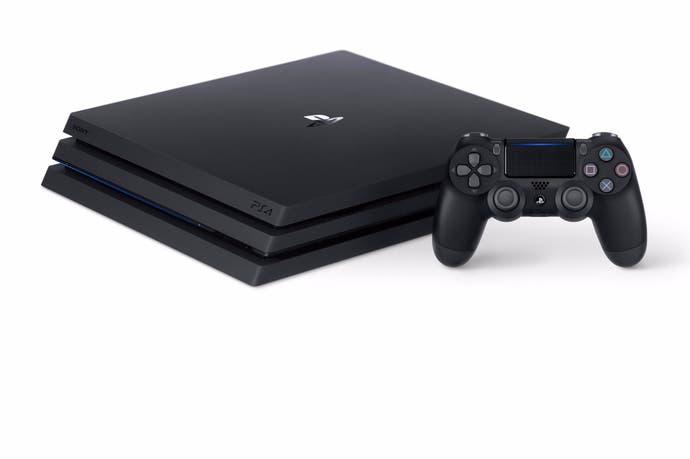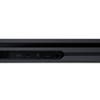Digital Foundry: Three hours with PlayStation 4 Pro
Has Sony really delivered a cutting-edge console worthy of 4K display technology?
I went into the PlayStation Meeting today as a sceptic, believing that the hardware may not be up to the task of powering a 4K display. The good news is that several hours later, I emerged from the event impressed with the quality of the experience and respectful of the wizardry utilised to make this GPU punch above its weight. However, fundamentally, there's little doubt that PlayStation 4 Pro is going to be a tough sell. Traditional gaming media simply can't capture and communicate the quality of the imagery I saw today, as there's no real way to showcase HDR meaningfully. And this is actually a key component of the PlayStation 4 Pro experience. 4K is impressive and a worthy upgrade in its own right, but HDR takes it to the next level.
But first, let's talk about the actual box itself. It turns out that the PlayStation 4 CUH-2000 'Slim' leak was even more significant than we realised. It was a preview of the design language that would carry across the entire PlayStation line, and the PS4 Pro (CUH-7000, designation fans) looks very much like a bigger brother of sorts - a bigger, fatter, triple-decker but with very similar design cues, right down to the collection of PlayStation symbols on the underside of the unit. Curiously, the LED strip-light found on the side of the CUH-1000 series PS4 has been relocated to the front of the machine, recessed into the lower 'slash'. And yes, finally, we have a rear USB 3.0 port in addition to a brace at the front.
It was not possible to get an idea of acoustics in the PlayStation Meeting environment, but max power consumption is rated at 310W - we assume that this is the maximum load capable by the PSU, not a typical system draw, bearing in mind that a PC running a Core i7 6700K with a Radeon RX 480 (an upclocked version of the Pro's core GPU tech) draws just 270W in our tests. The power supply is internal, but it is interesting to note that the old figure-eight power input is replaced by a sturdier 'kettle'-style socket - just like the launch model PlayStation 3.
Elsewhere, the system looks and feels very much like the standard PlayStation 4. As the PlayStation Meeting drew to a close, code was closed down and the systems dropped back to the front-end - where we saw a menu system virtually unchanged from the interface used on PS4 now. More functionality upgrades will come to the surface, we're sure, such as the 1080p Remote Play and sharing features, but what's clear is that it's not just the hardware design language that is unified between old hardware and new - it's the look and feel of the interface too.
- Pre-order the PlayStation 4 Pro from Amazon.
The real question is the extent to which PlayStation 4 Pro actually delivers a palpable upgrade, and whether Sony's hardware really can deliver a worthwhile experience for 4K displays. At a base level, we've already taken a look at the Polaris GPU technology and stress-tested it at multiple resolutions, finding that it is clearly not a native 4K capable part. However, there will be full 3840x2160 resolution software. Speaking to Naughty Dog at the event, we were told that The Last of Us Remastered - just like its base PS4 version - will have a 30Hz mode that features enhanced image quality. The existing PS4 game features higher resolution shadows maps and those are joined by a full, native 4K pixel count on the PS4 Pro. This drops down to a lower resolution at 60fps, where we're told to expect improved performance compared to the original release on base hardware.
And with Microsoft releasing press materials boasting about next year's Project Scorpio offering "true" 4K gaming, the question of upscaling must be addressed. In truth, the quality varies from one title to the next. Activision took to the stage talking of 4K and 60fps for Call of Duty: Infinite Warfare, then showed a section of gameplay that while impressive, was clearly neither. Stair-step edges are also evident in the new Mass Effect running on PS4 Pro, though the low contrast aesthetic of the level we saw hid most of the artefacts and the base resolution itself is still a big, big upgrade over standard 1080p.
However, a trio of the Sony first party efforts looked seriously impressive: Horizon Zero Dawn, Days Gone and Infamous First Light. All use the same cutting-edge upscaling technique. Previously we've talked about the 4x4 checkerboard process, where a 2x2 pixel block is extrapolated out into a 4x4 equivalent - next-gen upscaling, if you like. It allows developers to construct a 2160p 4K framebuffer from half the pixels - a much closer fit for the Pro's GPU prowess.
I first took a look at the results in Days Gone, the open world survival horror title from Sony Bend. I observed the pixel structure on a 65-inch Sony 4K display from just two feet away, and then I moved closer. It looked good, seriously good. There is a slight softness compared to the pin-sharp precision of a native 4K presentation, but even close-up, the effect works well - in a living room environment, it should work just fine. In common with the other titles using this technique, the demo code we saw can switch in real-time between 1080p and '4K' at the press of a button, with HDR on and off also selectable. There is a clear, unambiguous night and day difference between 1080p and the 4K mode, which is clearly resolving more than the basic 2x increase in pixel throughput being generated at the base level. In fact, the detail increase is almost revelatory - and that applies equally to both Days Gone and Horizon Zero Dawn.
Infamous First Light also shows a colossal improvement, but it's interesting to note that pausing the game while the screen is packed with explosive neon effects shows the base checkerboard effect can sometimes manifest around certain elements - principally the main character's neon lightning effects. It's virtually invisible in motion - but the same can't be said for Deus Ex: Mankind Divided's upscaling method where visual pixel crawl was easy to see. It's pre-production code obviously (performance looked visibly worse than the base PS4 game - something Sony actively prohibits in its technical requirements for Pro software), and didn't look quite right. The demo was unattended, so asking for technical details on the scaling method used wasn't possible.
Speaking to developers on site, several aspects of the checkerboard technology came into focus. Up until now, we've seen it as a software post-process upscale, but in actual fact, it's one of a number of new custom features backed into the PS4 Pro's GPU and as such comes with zero cost to game developers. We also understand that while it is a hardware feature, game-makers do seem to have a certain level of control - which may perhaps explain why different games exhibit varying levels of artefacting.
But the key takeaway is this - while the PlayStation 4 Pro GPU lacks the horsepower to render out challenging content at native 4K, the presentation we've seen on a number of titles clearly shows a worthwhile, highly desirable increase in fidelity over 1080p - one that does put a 4K screen to good use. Switching between full HD and checkerboard 4K, the increase in detail is simply stunning.
To its credit, Sony understands that a certain level of scepticism will persist here and to that end, several Sony developers on site told us that lead architect Mark Cerny will be going into the specifics of the custom hardware features in the next few weeks. Enticingly, we were also told that there was more to the GPU enhancements mentioned than just the checkerboard upscaler, so the details there should be fascinating.
The revelations do not end there, however. Many of the demos - all of the Sony efforts, in fact, including Uncharted 4 and The Last of Us Remastered - had HDR on/off toggles baked into the sample code. And this is where Sony is going to have real issues in 'selling' the upgrade on offer. On the top-end screens used at the event at least, HDR was hugely important to the quality of the presentation. The bottom line is simple - in some scenarios, HDR adds just as much extra detail as the additional resolution. In Horizon Zero Dawn, the skybox is transformed, on Uncharted 4, the beach on the island level we saw is washed out, completely lacking in texture until HDR is enabled. What's clear is that the perception of HDR having an impact on colour vibrancy is only half of the picture. Yes, contrast is massively improved, but in turn, this allows for much more detail to be resolved in the presentation.
And that makes the announcement of HDR support for all PlayStation hardware something of a big deal (yes the feature does extend to gaming). It's going to be fascinating to see just how this all works out at 1080p - something we didn't see at the event today. There's an argument that says that Sony handing out this free upgrade to existing PlayStation 4 users is likely to hinder Pro adoption - after all, this is a key feature of the new box. However, based on the hours spent with the hardware today, it seems far more likely that enabling this feature will work as a 'gateway drug' of sorts, a sampler for the full fat experience you'll only get with the Pro. After all, as far as we know, HDR support is only available on 4K screens thus far.
The importance of HDR - as impressive as it is in the flesh - will prove challenging to Sony, in the short term at least. First of all, it's a nightmare to market effectively. It's extremely difficult to show the HDR difference via standard media - screenshots and video won't cut it. Secondly, you're categorically missing something special by upgrading to a 4K screen that doesn't support HDR - meaning your choice of display is crucial. Thirdly, the way HDR is presented varies substantially between screens - it can look very, very different moving from one display to the next. The rule of thumb here is to buy a screen with the brightest panel possible, but then, as we experienced during our recent 4K HDR screen test, you may encounter issues in terms of input lag.
The startling reality - for now - is that Sony has created a cost-efficient box that is capable of getting great results from top-tier 4K display technology, but the cost of the right screen isn't going to be cheap for a long while. That said - the Panasonic DX750 we chose for our in-house display struck a great balance between affordability, HDR support and low input lag and we can't wait to test out PS4 Pro using it.
Other aspects of the PS4 Pro became evident during our various demos. First of all, while most developers seem intent on supporting enhanced resolutions and HDR, the fact is that users of 1080p screens will only benefit from super-sampling, and perhaps a smoother frame-rate on most titles. However, game-makers also have the opportunity to prepare different presentations depending on the screen attached. So if you have a 1080p display, you might see more lush visuals, whereas if you have a 4K display on tap, you may get a resolution boost. What's slightly concerning here is that it may well require adjusting resolution in the front end if, say, you'd prefer to take advantage of an enhanced 1080p mode rather than a less visually impressive 4K presentation. We rather hope developers will embrace Crystal Dynamics' approach with Rise of the Tomb Raider, where you can switch between the various modes on offer on the pause menu.
We can confirm that the reports are correct. Rise of the Tomb Raider has three different modes in the PS4 Pro version only: a 4K30 presentation with HDR support that strikes an impressive balance between visual features and resolution, a 1080p30 mode that ramps up quality settings to the max and an unlocked frame-rate mode for 1080p that sees performance vary between 40-60fps (we assume that this will be down to CPU bottlenecks), rather like Tomb Raider Definitive Edition on the standard PlayStation 4.
At the PlayStation Meeting, Crystal Dynamics were only showing the 4K mode. We've played a fair amount of this title recently, on both the Titan X Pascal and dual GTX 1080 SLI. It is, quite frankly, one of the finest 4K gaming experiences available. PS4 Pro is compromised a touch - it looks a little softer, and quality presets are pared back - but the core of the experience, the 'upgrade factor' over 1080p if you like, is there. This was by far and away the best third party 4K title we saw at the PlayStation Meeting.
Going into the event, there was a sense of familiarity with the PlayStation 4 Pro GPU - after all, we'd tested the same AMD Radeon Polaris technology in the RX 480 on PC and while there were some pleasant surprises in those tests it was clear that limitations on compute and memory bandwidth took native 4K off the table. To its credit, Sony readily agreed that the GPU had its limits, but the custom hardware and techniques in place are doing a good job of matching the system's capabilities with 4K display technology. From a personal perspective, I went into the PlayStation Meeting with a healthy scepticism and came out thinking that there is a cost-efficient console coming very soon that will indeed present a highly impressive upgrade option when paired with an ultra HD screen. There was no panic upgrade on the Neo spec - we're still looking at a 4.2 teraflop GPU - instead, Sony has opted for smart technology over raw rendering brute force, still achieving some really impressive results. This makes the PS4 Pro viable as a $399/£349 box.
This achievement is marred somewhat by the lack of UHD Blu-ray support - a remarkable omission for a device marketed as a 4K 'Pro' upgrade over the standard PlayStation 4. Perhaps it was required in order to hit the aggressive price-point, but equally it may well reflect a lack of interest from Sony itself in the format. Regardless, it leaves Microsoft in the interesting position of having the only console to run the UHD disc format and while actual take-up may be limited, it does take just a little of the sheen away from the Pro. The bottom line is this - if you're looking to invest a lot of money in a high-end 4K HDR display, you want an all-in-one box that gives you the most options for getting the most out of it. HDR media is limited at the moment as it is, so cutting off a potential source of content for your new screen really comes across as a little short-sighted.
But beyond the tech, what seems clear is that PS4 Pro will launch with a robust line-up of games - a mixture of enhanced new titles and a bunch of old favourites. While we fully expected to see Uncharted 4 at the event, the arrival of Infamous First Light (Second Son will also be patched) and The Last of Us Remastered was a delight. Everything we saw suggested that there are plenty of good reasons to return to these titles.
Going forward, the challenge remains. PS4 Pro will offer boosts to those with 1080p screens, but the impact will be limited and the big gain really is in 4K and HDR. We've noted some apathy towards 4K gaming but based on today's showing, the results are mostly very impressive. What we saw today is an upgrade worth having, but the reality is stark - right now, you're not just looking at a console upgrade, but one that practically demands a new display purchase too. And the issue there is that getting the best 4K HDR experience certainly isn't cheap, even when PS4 Pro itself looks set to offer great value. It's a potential minefield and one we'll be hoping to guide you through once the new PlayStation 4 Pro launches.
PlayStation 4 Pro was unveiled at an event in New York that we attended. Sony paid for travel and accommodation.

























